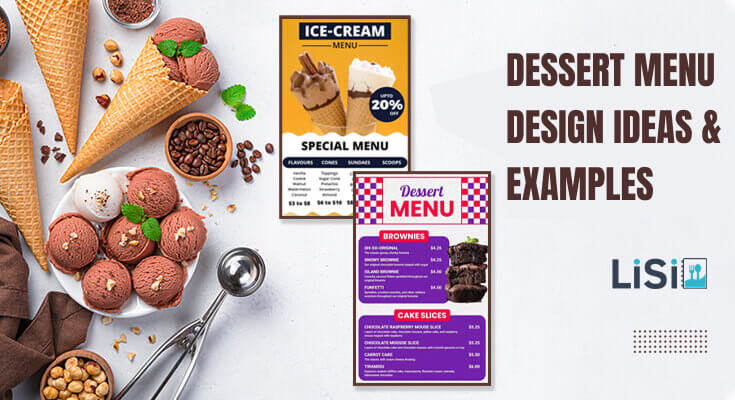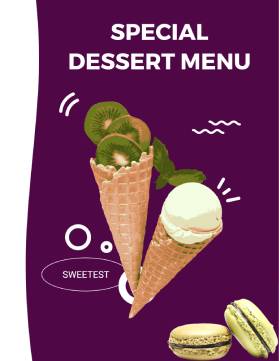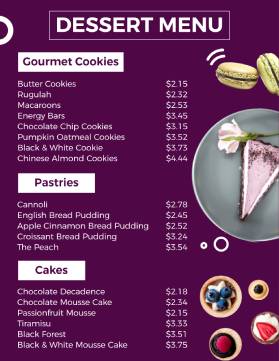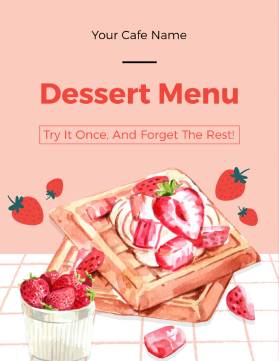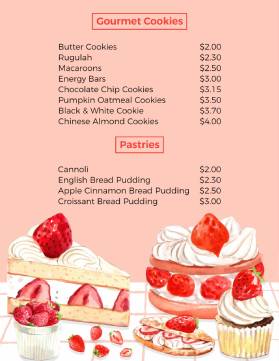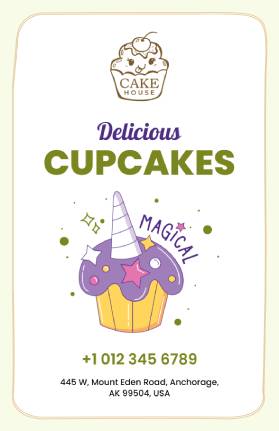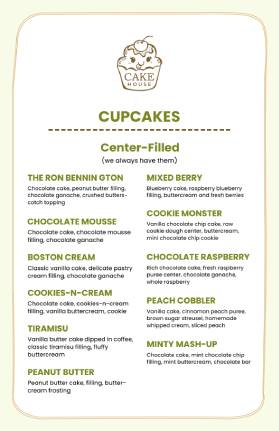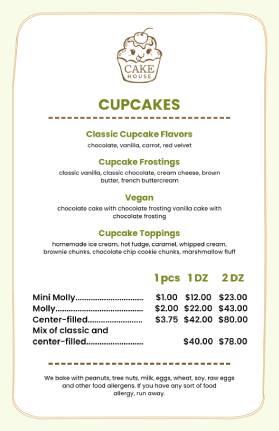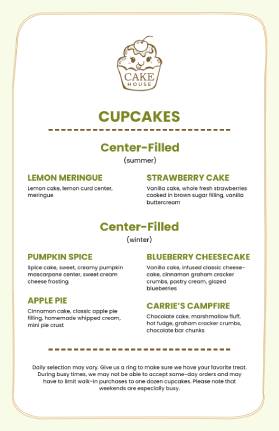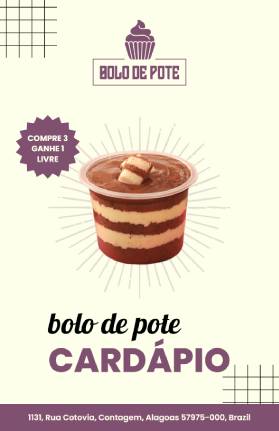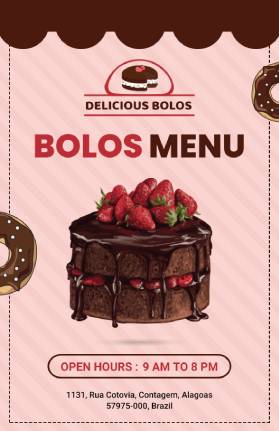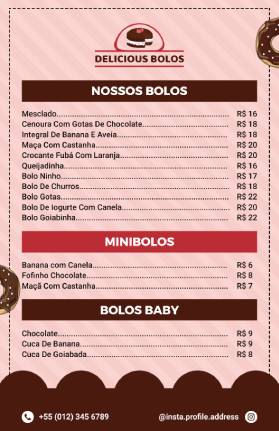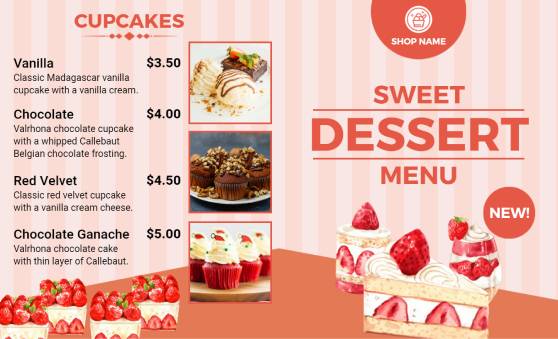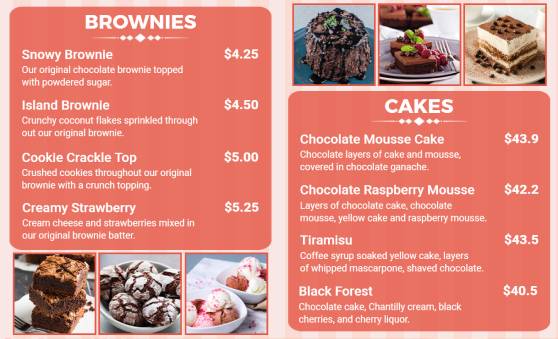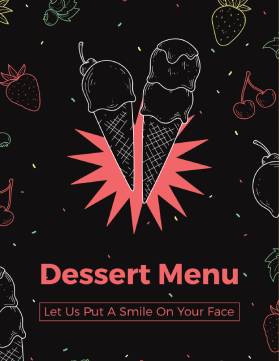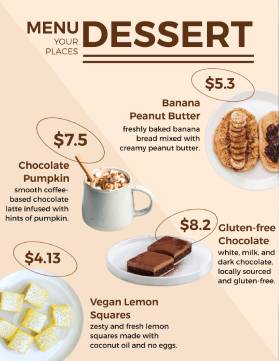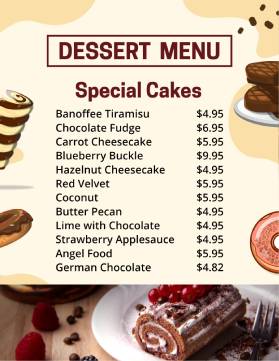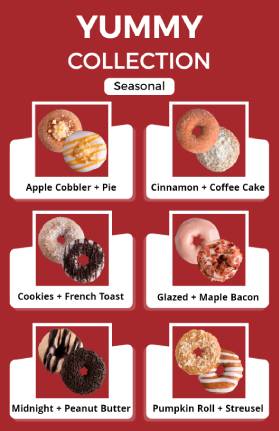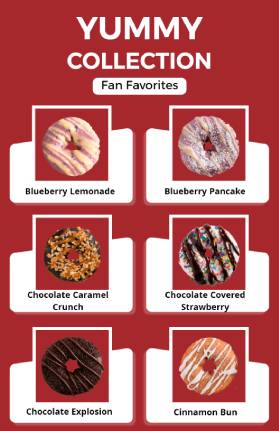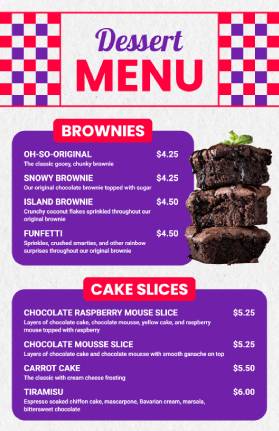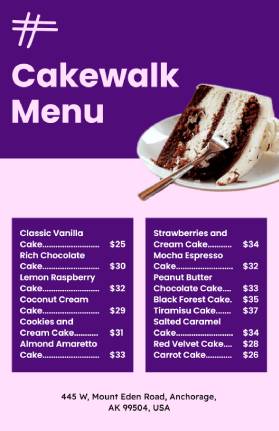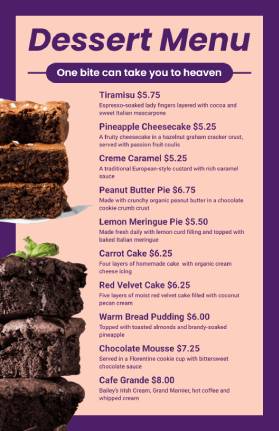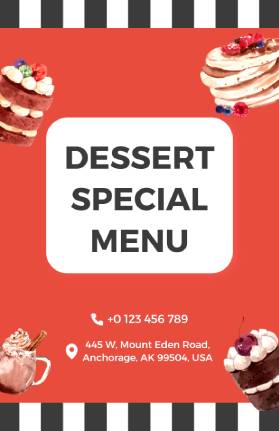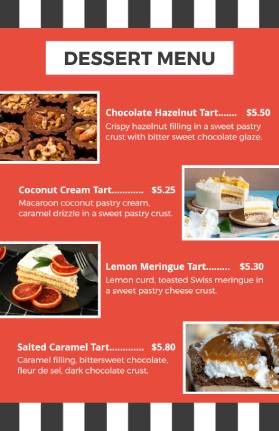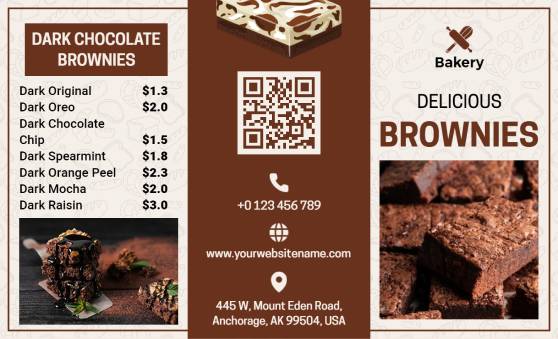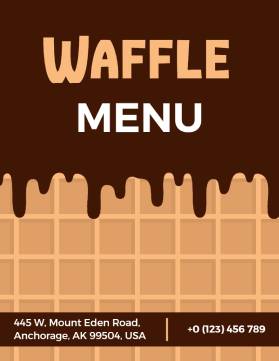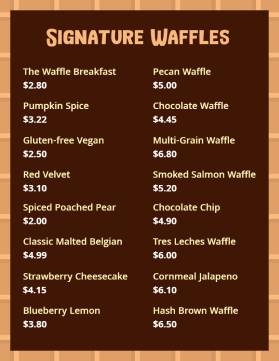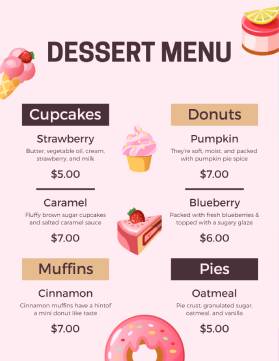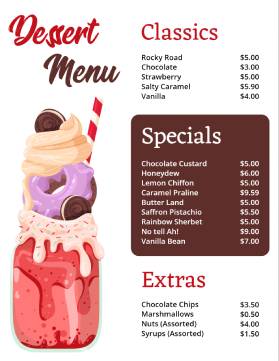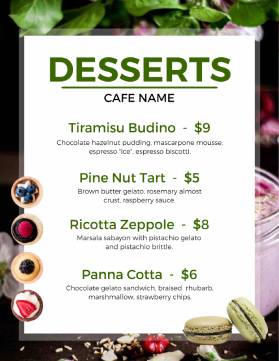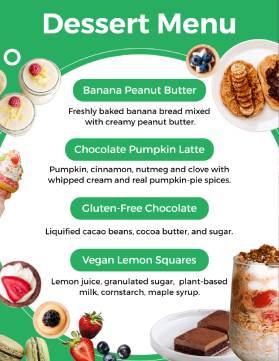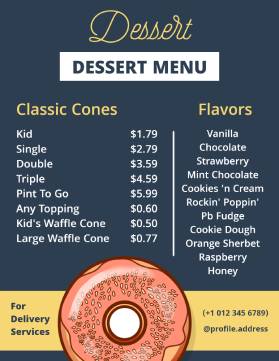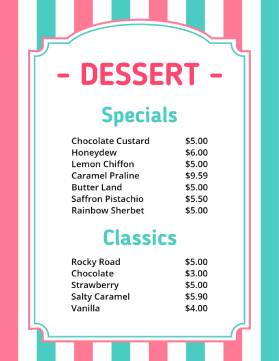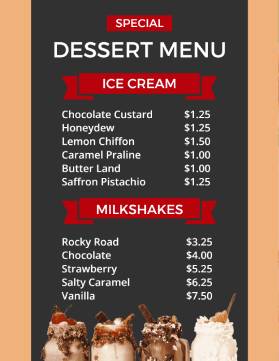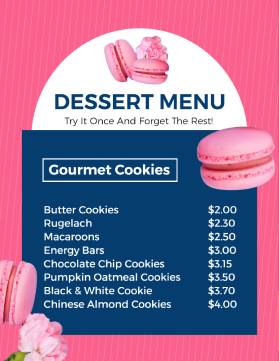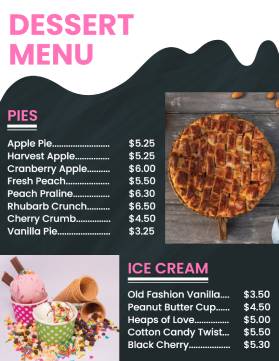Are you looking for dessert menu design ideas and examples? You’re on the right page. A strategic menu design can significantly boost your restaurant’s revenue while enhancing customer satisfaction. Moreover, a well-crafted dessert menu serves as the perfect finale to any dining experience.
Restaurant owners often underestimate the power of dessert sales. However, desserts typically offer higher profit margins than main courses. Furthermore, an appealing dessert menu design encourages customers to extend their stay and increase their total bill.
What Makes a Dessert Menu Design Truly Effective?
Effective dessert menu design combines visual appeal with strategic psychology. Additionally, successful menus guide customers toward high-margin items while creating excitement about sweet endings to their meals.
Understanding Customer Psychology in Menu Design
Customer behavior changes dramatically when they reach dessert decisions. Initially, diners feel satisfied with their main course. Therefore, your dessert menu must reignite their appetite and create new cravings.
Consequently, effective dessert menus use specific design elements:
- Visual triggers that stimulate appetite
- Descriptive language that creates sensory experiences
- Strategic positioning of high-profit items
- Price anchoring techniques
- Emotional connections through storytelling
The Science Behind Successful Menu Psychology
First, you must be aware of menu design psychology, research shows that customers spend only 109 seconds reading menus on average. Therefore, your dessert menu design must capture attention immediately. Furthermore, strategic placement of items can increase sales by up to 30%.
Similarly, using descriptive adjectives increases item sales significantly. For instance, “decadent chocolate lava cake” outsells “chocolate cake” by substantial margins.
What are the Best Dessert Menu Design Examples and Ideas?
When looking for cool dessert menu design examples for your bakery or restaurant, it’s important to focus on simplicity and visual flow. Below you can find some inspiration, and easily customize any menu template to create the best one that not only captures attention but also boosts your orders.
These were the best dessert menu design examples, and if you are a restaurant or bakery shop owner struggling to create a dessert menu, head on to online menu maker, which is an easy-to-use platform, allowing you to customize any menu template you choose, and create a perfect menu quickly.
How Do Visual Elements Impact Dessert Menu Success?
Visual design elements directly influence customer choices and spending patterns. Moreover, professional dessert menu design creates perceived value that justifies premium pricing.
1. Color Psychology in Dessert Menu Design
Colors trigger specific emotional and physiological responses. Consequently, selecting the right color palette becomes crucial for the success of a dessert menu.
Warm colors like red, orange, and yellow:
- Stimulate appetite naturally
- Create feelings of warmth and comfort
- Encourage quick decision-making
- Generate excitement about indulgent treats
Cool colors like blue and green:
- Suggest freshness and natural ingredients
- Appeal to health-conscious customers
- Works well for fruit-based desserts
- Create calming, sophisticated atmospheres
Additionally, gold and bronze accents convey luxury and premium quality. Therefore, upscale restaurants often incorporate these colors strategically throughout their dessert menu design.
2. Typography Choices That Drive Sales
Font selection significantly impacts readability and customer perception. Furthermore, typography communicates your restaurant’s personality before customers read a single word.
Script fonts work beautifully for:
- Traditional bakeries and cafes
- Romantic, intimate dining establishments
- Vintage or classic-themed restaurants
- Artisanal dessert presentations
Modern sans-serif fonts excel in:
- Contemporary dining spaces
- Fast-casual restaurant environments
- Health-focused establishments
- Minimalist design approaches
However, avoid overly decorative fonts that sacrifice readability. Instead, combine elegant headers with clean, readable body text for optimal results.
Recommended: If you aren’t sure about which typography and color scheme for menu design works best, reading this guide might be helpful to you.
3. Strategic Use of White Space and Layout
White space, also called negative space, plays a crucial role in menu effectiveness. Moreover, proper spacing prevents overwhelming customers with too much information simultaneously. A well-structured layout with enough breathing space improves readability, guides the customer’s eyes naturally, and creates a clean, modern, and premium feel. It also helps highlight key items and directs attention to the most profitable desserts.
Effective dessert menu layouts typically feature:
- Generous margins that frame content elegantly
- Clear sections separating different dessert categories
- Adequate line spacing for comfortable reading
- Strategic groupings of related items
- Visual breaks between major sections
4. Appetizing Food Photography Boosts Cravings
High-quality food photography is one of the most powerful elements of a successful dessert menu. When customers see a rich, gooey chocolate brownie or a perfectly glazed fruit tart in a photo, it instantly triggers their senses and stirs cravings. People naturally eat with their eyes first, and an appealing image can do more to sell a dessert than words ever could.
Instead of imagining what a dish might look like, customers get a clear and tempting visual that helps them make quicker decisions. Well-lit, close-up images with minimal distractions highlight the textures, colors, and freshness of your desserts.
Benefits of using real photos:
- Increases emotional appeal.
- Sets accurate expectations.
- Helps undecided customers make a choice faster.
- Encourages impulse purchases.
Tips:
- Use professional photography or natural lighting.
- Avoid stock images—use photos of your actual desserts.
- Keep backgrounds clean and colors warm to make desserts stand out.
5. Icons and Illustrations Add Personality
Icons and illustrations are small design elements that can bring big personality to your dessert menu. They help create a fun, engaging experience for the customer, especially in casual, family-friendly, or themed restaurants. A simple cupcake icon next to a bakery item or a small snowflake next to a frozen dessert makes the menu easier to skim and visually interesting.
These visuals also help break up text-heavy layouts and guide customers to key items. In digital or print menus, illustrations add a human touch and can reflect your brand’s tone—whether playful, elegant, or artisanal.
Smart ways to use icons and illustrations:
- Add a heart icon for bestsellers or customer favorites.
- Use themed symbols like cherries, spoons, or stars to highlight special items.
- Include allergy or dietary icons (e.g., gluten-free, vegan) for quick identification.
- Draw small, hand-sketched visuals for a rustic or homemade feel.
Apart from these icons and illustrations, there are many essential menu design elements you must consider before crafting a dessert menu.
6. Highlighting Limited-Time Offers or Seasonal Desserts
Limited-time offers and seasonal desserts create a sense of urgency and excitement on a menu, and visual elements play a key role in making them stand out. Customers are more likely to try something special if it feels exclusive or tied to a particular season or celebration.
Using distinct visual cues—like colorful borders, banners, or background accents—can draw attention to these featured items without overwhelming the rest of the menu. Seasonal themes (like snowflakes for winter or tropical icons for summer) not only add charm but also help communicate freshness and relevance.
Effective ways to highlight specials:
- Use a bold ribbon or badge with text like “New,” “Seasonal,” or “Chef’s Pick.”
- Place seasonal items in a shaded or colored section of the menu.
- Add small themed illustrations (pumpkins, holly leaves, hearts) to reflect holidays.
- On digital menus, animate these elements or use QR codes to reveal rotating desserts.
What Are the Most Effective Dessert Menu Categories?
Organizing desserts into logical categories helps customers navigate choices efficiently. Additionally, smart categorization allows you to highlight signature items and seasonal specialties.
1. Classic Comfort Desserts
Comfort desserts represent the foundation of most successful dessert menus. Furthermore, these familiar favorites provide reliable revenue streams while satisfying traditional customer expectations.
Popular comfort dessert categories include:
- Chocolate indulgences (brownies, chocolate cake, mousse)
- Fruit-based classics (apple pie, berry crumbles, tarts)
- Creamy favorites (cheesecake, puddings, ice cream)
- Warm treats (bread pudding, cobblers, soufflés)
These desserts often feature nostalgic descriptions that evoke childhood memories. Consequently, customers feel emotional connections that justify higher prices and encourage ordering.
2. Seasonal and Limited-Time Offerings
Seasonal desserts create urgency while showcasing your kitchen’s creativity. Moreover, rotating offerings encourage repeat visits as customers anticipate new seasonal treats.
Spring dessert features might include:
- Fresh berry tarts with lemon curd
- Strawberry shortcake variations
- Light citrus-based desserts
- Floral-infused treats like lavender crème brûlée
Summer specialties often highlight:
- Frozen desserts and sorbets
- Stone fruit cobblers and galettes
- Refreshing no-bake options
- Outdoor dining-friendly presentations
Fall favorites typically showcase:
- Pumpkin and spice-flavored treats
- Apple-based desserts in various forms
- Warm, comforting presentations
- Harvest-themed ingredient combinations
Winter offerings usually feature:
- Rich, indulgent chocolate creations
- Warm desserts perfect for cold weather
- Holiday-inspired flavor combinations
- Celebratory presentation styles
If you are preparing seasonal menu planning to increase sales for your restaurant or dessert shops, check out this guide.
3. Health-Conscious and Dietary-Restriction Options
Modern dessert menus must accommodate various dietary needs and health preferences. Additionally, offering inclusive options expands your customer base significantly.
Essential dietary categories include:
- Gluten-free desserts using alternative flours
- Vegan options featuring plant-based ingredients
- Sugar-free alternatives for diabetic customers
- Dairy-free treats for lactose-intolerant diners
- Keto-friendly desserts for low-carb dieters
However, avoid segregating these options into separate sections. Instead, integrate them naturally throughout your menu while marking dietary accommodations.
How Can You Create Compelling Dessert Menu Descriptions?
Exceptional dessert descriptions transform simple menu items into irresistible experiences. Furthermore, strategic language choices can increase item sales by 25% or more.
1. Sensory Language That Sells
Effective words to describe foods can engage multiple senses simultaneously. Moreover, vivid language helps customers imagine flavors, textures, and aromas before ordering.
Texture words that drive sales include:
- Silky, smooth, creamy for custards and mousses
- Crisp, flaky, buttery for pastries and crusts
- Rich, dense, fudgy for chocolate desserts
- Light, airy, fluffy for soufflés and cakes
Flavor descriptors that create cravings:
- Decadent, indulgent, luxurious for premium items
- Fresh, bright, zesty for fruit-based desserts
- Warm, comforting, nostalgic for classic treats
- Bold, intense, complex for sophisticated options
2. Storytelling Through Menu Descriptions
Stories create emotional connections that justify premium pricing. Additionally, narratives help customers remember specific desserts long after dining.
Effective storytelling techniques include:
- Origin stories about recipe development
- Cultural backgrounds of traditional desserts
- Seasonal inspirations behind limited offerings
- Chef’s personal connections to specific treats
- Local ingredient sourcing narratives
For example: “Our grandmother’s apple pie recipe, passed down through four generations, features locally-sourced apples from Morrison’s Orchard, wrapped in our signature butter-flaky crust.”
3. Price Presentation Strategies
Price presentation significantly impacts customer perception and ordering behavior. Therefore, strategic menu pricing techniques can boost average dessert sales substantially.
Effective pricing strategies include:
- Removing dollar signs to reduce price focus
- Using consistent decimal places for a professional appearance
- Grouping similar price points together
- Anchoring expensive items to make others seem reasonable
- Bundling options like dessert and coffee combinations
What Dessert Menu Layouts Work Best for Different Restaurant Types?
Different restaurant styles require unique dessert menu design approaches. Moreover, your layout should complement your overall brand identity and dining atmosphere.
1. Fine Dining Dessert Menu Design
Upscale restaurants demand sophisticated dessert menu presentations. Furthermore, elegant design reinforces premium positioning and justifies higher price points.
Fine dining design elements typically include:
- Premium paper stocks with substantial weight and texture
- Minimalist layouts with generous white space
- Limited color palettes emphasizing elegance
- Professional photography or artistic illustrations
- Detailed ingredient lists showcasing quality components
Additionally, fine dining menus often feature fewer options presented with extensive descriptions. Consequently, each dessert receives individual attention and careful consideration.
2. Casual Dining Menu Approaches
Family restaurants and casual establishments need approachable, user-friendly dessert menu designs. Moreover, these menus should appeal to diverse age groups and preferences.
Casual dining design characteristics include:
- Colorful, vibrant presentations that attract attention
- Clear, readable fonts suitable for all ages
- Strategic use of images to showcase popular items
- Organized categories for easy navigation
- Value-focused pricing presentations
Furthermore, casual dining menus often include sharing options and kid-friendly choices prominently featured.
3. Fast-Casual and Quick Service Solutions
Quick-service restaurants require efficient dessert menu designs that facilitate rapid ordering decisions. Additionally, these menus must work effectively for both in-person and digital ordering platforms.
Fast-casual design priorities focus on:
- Simplified layouts with minimal text
- Bold, eye-catching visuals that communicate quickly
- Clear pricing that’s easy to read at a distance
- Limited options to prevent decision paralysis
- Digital-friendly formats for online ordering integration
How Do Seasonal Updates Keep Dessert Menus Fresh?
Regular menu updates maintain customer interest while maximizing seasonal ingredient availability. Moreover, strategic seasonal changes can significantly boost dessert sales throughout the year.
Planning Your Seasonal Dessert Calendar
Successful seasonal planning requires preparation and strategic timing. Additionally, coordinating with local suppliers ensures ingredient availability and optimal pricing.
Seasonal planning timeline recommendations:
- Three months ahead: Finalize seasonal concepts and supplier agreements
- Two months ahead: Complete recipe testing and cost analysis
- One month ahead: Design new menu materials and train staff
- Launch week: Implement marketing campaigns and monitor customer response
Transitional Seasonal Offerings
Smart restaurants create bridge offerings that transition smoothly between seasons. Furthermore, these transitional items extend the popular seasonal ingredients’ menu life.
Successful transition strategies include:
- Late summer: Combining stone fruits with early fall spices
- Early winter: Blending autumn flavors with holiday elements
- Late winter: Incorporating citrus with early spring ingredients
- Early summer: Mixing spring berries with warm-weather presentations
What Technology Integration Enhances Modern Dessert Menus?
Digital integration transforms traditional dessert menu experiences. Moreover, technology solutions can streamline operations while enhancing customer engagement.
QR Code Menu Implementation
QR code menu designs gained popularity during recent years and continue providing valuable benefits. Additionally, digital menus offer flexibility and real-time updating capabilities.
QR menu advantages include:
- Instant updates for pricing and availability changes
- Multi-language options for diverse customer bases
- Interactive features like ingredient information and allergen alerts
- Cost savings on printing and reprinting expenses
- Analytics capabilities, tracking popular items and customer preferences
Digital Menu Board Solutions
Electronic displays allow dynamic dessert presentations with rotating featured items. Furthermore, digital boards can showcase appetizing images and videos that static menus cannot match.
Digital board benefits encompass:
- Time-based displays highlighting appropriate desserts for different meal periods
- Weather-responsive content promoting seasonal items based on current conditions
- Inventory integration automatically removes sold-out items
- A/B testing capabilities for optimizing item performance
- Remote management across multiple locations
What Common Dessert Menu Design Mistakes Should You Avoid?
Understanding frequent design pitfalls helps create more effective dessert menus. Moreover, avoiding these mistakes can prevent lost sales opportunities and customer frustration.
1. Overcrowding and Information Overload
Too many options or excessive information overwhelm customers and slow decision-making. Consequently, overcrowded menus often result in lower dessert sales and customer satisfaction.
Signs of menu overcrowding include:
- More than 12-15 dessert options for most restaurants
- Dense text blocks without adequate white space
- Multiple fonts and colors competing for attention
- Cluttered layouts with insufficient organization
- Overwhelming ingredient lists for simple desserts
2. Poor Photography and Visual Elements
Low-quality images detract from dessert appeal and perceived value. Additionally, inconsistent visual styles create unprofessional impressions that undermine premium positioning.
Common visual mistakes encompass:
- Amateur photography with poor lighting or composition
- Inconsistent styling, mixing different photographic approaches
- Outdated images that don’t match current presentations
- Overuse of stock photos that lack authenticity
- Poor image resolution, appearing pixelated or blurry
3. Using Poor Quality or No Images
Desserts are highly visual, and failing to include images or using poor-quality ones can significantly weaken your menu’s impact. A menu without photos relies solely on text, which may not fully capture the richness, texture, or appeal of your desserts. On the other hand, blurry, dark, or heavily filtered photos can make even the most delicious desserts look unappetizing. Customers are far more likely to order a dessert when they can see what they’re getting.
Tips to avoid this mistake:
- Use clear, high-resolution images taken in natural light.
- Showcase your actual desserts, not stock photos.
- Limit the number of photos to keep the menu clean and focused.
- Highlight 1–3 key desserts with mouthwatering visuals for maximum effect.
4. Not Highlighting Bestsellers or Specials
When a dessert menu treats every item the same, customers may feel unsure about what to choose — especially if they’re unfamiliar with the offerings. Not highlighting your bestsellers or specials is a missed opportunity to guide their decisions and increase sales.
Customers often look for recommendations, and featuring popular or high-margin desserts makes their choices easier and faster. Visual cues, like badges or borders, can help certain items stand out and encourage impulse orders. Without these highlights, standout desserts can get lost in the crowd, and customers may default to skipping dessert altogether.
Tips to avoid this mistake:
- Use labels like “Chef’s Favorite,” “Most Popular,” or “Customer Favorite.”
- Place top-performing items at the top or center of the menu section.
- Add a visual cue like a star, icon, or colored background.
- Occasionally rotate specials and highlight seasonal or limited-time items.
5. No Branding Consistency
Your dessert menu should match the look and feel of the rest of your restaurant or main menu. If it feels out of place, it breaks the customer experience.
Avoid this by:
- Use the same fonts, color schemes, and logo as your main branding.
- Matching the tone of your menu (fun, elegant, rustic, modern, etc.).
- Keeping the design layout consistent across dine-in, takeaway, and online versions.
6. Missing or Confusing Pricing
When dessert menus have missing, hidden, or confusing pricing, it can frustrate customers and lead to hesitation or skipped orders. If guests can’t easily find the price, they may assume the item is expensive or feel uncomfortable asking. On the flip side, if prices are too bold or distracting, they might draw attention away from the appeal of the dessert itself. The goal is to present prices clearly and subtly, giving customers the information they need without making cost the main focus. A clean, balanced approach builds trust and encourages more confident ordering.
Tips to avoid this mistake:
- Place prices next to or just below the item name in a smaller, lighter font.
- Use consistent formatting (all prices aligned right or all inline).
- Avoid using dotted lines or symbols that lead the eye straight to the price.
- Double-check for missing prices — even one unpriced item can confuse.
We’ve also covered a guide on what restaurant menu design mistakes to avoid and how to craft the perfect menu that attracts customers.
Frequently Asked Questions
1. What makes a dessert menu visually appealing?
A visually appealing dessert menu uses high-quality images, attractive fonts, a clear layout, and consistent colors. It should be easy to read and guide the customer’s eye naturally. Adding white space, dessert categories, and visual hierarchy makes the menu feel clean and professional.
2. Should I use images in my dessert menu?
Yes, using images can greatly improve your dessert menu. People eat with their eyes first, and delicious-looking photos can tempt them to order. Just make sure the photos are high-quality, well-lit, and show your actual desserts—not stock images.
3. What colors work best for dessert menus?
Soft colors like pastels (pink, mint, cream) give a sweet and elegant vibe. Rich tones like brown, red, and gold work well for chocolatey or luxurious desserts. Avoid using too many bright or clashing colors. Stick to a color palette that matches your brand.
4. How should I organize items on my dessert menu?
Organize desserts into clear categories like Cakes, Ice Creams, and Seasonal Specials. Place bestsellers or signature items at the top or center of each section. Keep the layout simple and avoid cramming too many items on one page.
5. How can I highlight seasonal or limited-time desserts?
Use visual cues like colored banners, icons, or “Limited Time” labels to draw attention. You can also group seasonal items in a separate section or add themed illustrations like snowflakes or hearts to reflect holidays or seasons.
6. What type of font is best for a dessert menu?
Choose fonts that are easy to read and match your brand’s tone. Script fonts can add elegance, while modern sans-serif fonts give a clean and fresh feel. Use bold text for headings and keep item descriptions in a regular, readable size.
Conclusion
These are the best dessert menu design ideas and examples that may help you boost your sales and profitability. Moreover, well-designed menus enhance customer satisfaction while increasing average check sizes significantly.
Remember that effective dessert menu design combines visual appeal with psychological insights and operational practicality. Furthermore, regular updates and continuous optimization ensure sustained success in competitive restaurant markets.
By implementing the strategies and ideas outlined in this comprehensive guide, you can create dessert menus that not only look professional but also drive measurable business results. Additionally, staying informed about emerging trends and customer preferences will help maintain your competitive edge.

